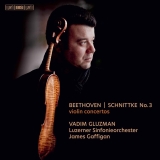Beethoven war der erste, der mit seinem Violinkonzert ein neues Verhältnis zwischen dem Solisten und dem Orchester schuf. Außerdem zeigte er den Spielereien der Virtuosen eine Grenze auf, allerdings erst im 5. Klavierkonzert, in dem er die Kadenzen mitkomponierte. Da er das beim Violinkonzert noch nicht getan hat, haben sich seither etliche Kadenzen etabliert, aus denen jeder aktuelle Künstler auswählen kann.
Gluzman schlägt mit den von Schnittke entworfenen Partien den Bogen in die Gegenwart und zu dem zweiten eingespielten Werk. Im dritten Konzert von Schnittke geht die Auflösung der klassischen Form schon mit der Besetzung aus 13 Bläsern und Streichquartett los und noch weiter, indem er die klassische Tempofolge umkehrt und einen schnellen Mittelsatz zwischen zwei langsame setzt.
Diese Kadenzen von Schnittke für Beethoven sind sehr selten zu hören, obwohl sie einen so eleganten wie sensiblen Übergang ins Heute bieten. Mit Zitaten aus Konzerten von Bach, Beethoven, Berg, Brahms, Mozart, Ysaÿe, Schönberg und schließlich Schnittke selbst führen sie durch die Geschichte des Violinkonzertes. Seit seiner Kindheit hat Gluzman eine besondere Beziehung mit der Musik von Schnittke verbunden. Er empfindet seine Musik als immer wahr und ehrlich und er fühlt sich der Musik sehr nahe.
Und entsprechend der Sicht des Geigers, der das Konzert von Beethoven für sein lyrischstes hält und ihm doch auch die immer präsente und offensichtliche Kraft des Geistes attestiert, hat er seine Deutung angelegt. Mit antivirtuoser Herangehensweise zieht er ihm sofort den Zahn des Auftrumpfens, gibt damit allein der Musik den Platz, sich zu entfalten. Das macht diesen Ansatz zu einem ebenso feinen wie zuhörenswerten Erlebnis. Darin entwickelt er zunächst den dramatischen Ausdruck mit dem Höhepunkt der abgründigen Kadenz von Alfred Schnittke, während das Orchester den Dialog mit ihm kammermusikalisch formuliert. Dass dabei Fragen der Beherrschbarkeit der Materie aber auch gar keine Rolle spielen, mag man bei Gluzman voraussetzen, aber trotzdem kann man es auch genießen. Er nutzt dies für feingliedrige Artikulation und dazu, die Bögen zu unendlichen Melodien zu formen.
So wie das Konzert von Beethoven mit dem Paukenmotiv einen unerhörten Anfang hat, so setzt Alfred Schnittke in seinem Konzert Nr. 3 die Kadenz sozusagen als Eingangskadenz an den Beginn. Die kammermusikalische Anlage des Violinkonzerts wird vor allem vom polyphon konfrontativen Gespräch zwischen Solovioline und Bläsern geprägt. Irgendwie sind die Werke sehr unterschiedlich und trotzdem lassen sich gleichartige Details festmachen wie bei beiden die ausgefeilte Struktur, die für die Werke große Bedeutung hat.
Es ist das Verdienst von Gluzman, dass er hier nicht nur die Verbindung von Beethoven zu Schnittke herstellt, sondern durch sein intensives und beredtes Spiel die Visionen großer Künstler vermittelt und damit hoffnungsvoll in die Zukunft blickt. Davon gerne mehr, überall!
Beethoven was the first to create a new relationship between the soloist and the orchestra with his Violin Concerto. He also showed a limit to the gimmicks of the virtuosos, but only with the 5th Piano Concerto, in which he co-composed the cadenzas. Since he did not do so in the Violin Concerto, quite a few cadenzas have since been established from which any current artist can choose. Gluzman chooses the cadenzas designed by Schnittke to link the present and the second work recorded. In Schnittke’s Third Concerto, the dissolution of classical form starts with the instrumentation of 13 winds and string quartet and goes even further by reversing the classical tempo sequence and placing a fast middle movement between two slow ones.
These cadenzas by Schnittke for Beethoven are very rarely heard, though they offer a transition to the present as elegant as they are sensitive. With quotations from concertos by Bach, Beethoven, Berg, Brahms, Mozart, Ysaÿe, Schoenberg and finally Schnittke himself, they take us through the history of the violin concerto. Especially since Gluzman has had a special relationship with Schnittke’s music since childhood, he feels that his music is always true and honest, and he feels very close to it.
And according to the violinist’s point of view, who considers Beethoven’s concerto his most lyrical and yet also attests to the ever-present and obvious power of the spirit, he has laid out his interpretation. With an antivirtuoso approach, he immediately removes any showiness, thus giving the music alone the space to unfold. This makes this approach an experience that is as fine as it is worth listening to. In it, he first develops the dramatic expression with the climax of Alfred Schnittke’s abysmal cadenza, while the orchestra formulates the dialogue with him in a chamber-musical manner. That questions of mastery of the material play no role at all in this may be taken for granted by Gluzman, but nevertheless one can also enjoy it. He uses this for delicate articulation and to shape the bows into endless melodies.
Just as Beethoven’s concerto has a special beginning with the timpani motif, Alfred Schnittke places the cadenza at the beginning of his Concerto No. 3. The chamber music layout of the violin concerto is characterized above all by the polyphonically confrontational conversation between solo violin and wind instruments. Somehow the works are very different and yet similar details can be noted, such as in both the elaborate structure, which is of great importance to the works.
It is to Gluzman’s credit that he not only makes the connection from Beethoven to Schnittke here, but also conveys the visions of great artists through his intense and eloquent playing, and thus looks to the future with hope. More of that with pleasure, everywhere!
























